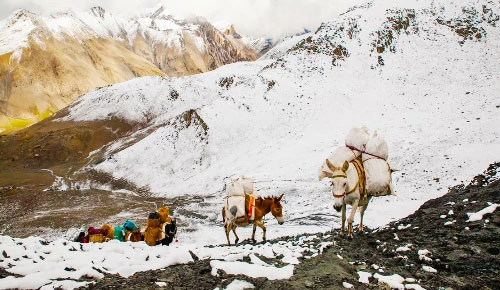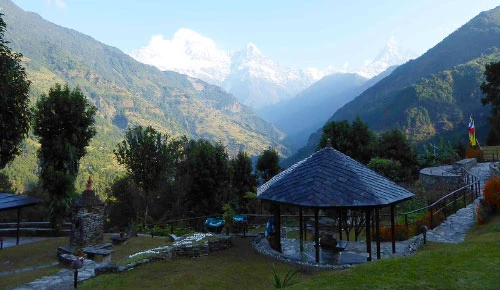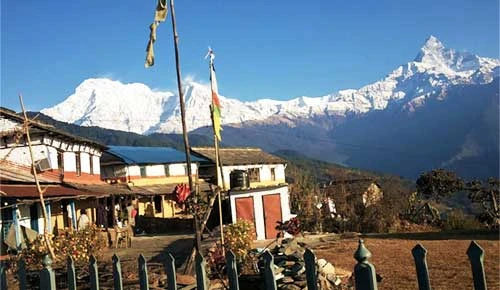Lo Manthang Travel Guide
Lo Manthang is a village located in the Upper Mustang region of Nepal, near the Tibetan border. It is the capital of the former Kingdom of Lo, which was an independent state until 2008 when it was integrated into the Republic of Nepal.
Lo Manthang is known for its unique culture, history, and architecture. A 15th-century mud-brick wall surrounds the village, and its narrow streets are lined with traditional Tibetan-style houses, some of which have intricate carvings and paintings. The village is also home to the royal palace, or "gumba," which was built in the 15th century and is still used for religious ceremonies.
The region around Lo Manthang is characterized by its stark, arid landscapes, dotted with ancient caves, monasteries, and other cultural sites. The area is popular with trekkers and adventure-seekers, who come to explore its rugged terrain and unique cultural heritage.
Access to Lo Manthang is restricted, and visitors must obtain a special permit to enter the Upper Mustang region. This helps to preserve the unique cultural heritage of the area, but it also means that visiting Lo Manthang can be a challenging and expensive undertaking.
History
Lo Manthang was the capital city of the Kingdom of Lo. Kingdom of Lo is the formal name of Upper Mustang. The Upper Mustang was a restricted kingdom until 1992. Lo Manthang is one of the most preserved regions in the world. The People of Lo Manthang still speak the Tibetan Language. Still, you can see the city wall which is instructed under oversee of Ame Pal. Flag of the Mustang Kingdom, founded by Ame Pal in 1380.
Attractions
- The main attraction of Lo Manthang is the 15th-century Royal Palace, which served as the residence of the former King of Mustang.
- Several monasteries in Lo Manthang, such as Jampa Lhakhang, Thubchen Gompa, and Chodey Gompa, are significant religious sites and offer insights into the Buddhist culture and tradition.
- Offers panoramic views of the Himalayan mountain range, including Annapurna, Dhaulagiri, and Nilgiri.
- Lo Manthang is an excellent destination for trekking, with several trails that take you through the picturesque landscapes of the Upper Mustang region.
- A unique culture and tradition that is distinct from the rest of Nepal. Visitors can explore the local lifestyle, cuisine, and festivals to get a glimpse of their culture.
Weather and Climate
Lo Manthang is a small town situated in the Upper Mustang region of Nepal, and it has a high altitude of 3,810 meters (12,500 feet) above sea level. The climate of Lo Manthang is mostly dry, cold, and windy throughout the year due to its high altitude and its location in the rain shadow of the Himalayas. The town receives an average annual rainfall of only 150 mm, making it one of the driest regions in Nepal.
The weather in Lo Manthang is characterized by cold winters and warm summers. The winter season, from December to February, is extremely cold, with temperatures dropping to as low as -15°C (5°F) at night. The daytime temperature during this season ranges from 4°C to 10°C (39°F to 50°F). Snowfall is common during this period.
The summer season, from May to September, is comparatively warmer, with temperatures ranging from 10°C to 20°C (50°F to 68°F). However, the days can be hot, with the temperature occasionally reaching 25°C (77°F). The monsoon season begins in June and lasts until September. During this season, the town receives occasional rainfall, but it is not heavy.
Lo Manthang has a unique weather pattern, with a dry and cold climate throughout most of the year. The best time to visit the town is during the spring and autumn seasons (March to May and September to November), when the weather is dry and mild, and the sky is clear.
Food and Accommodation
Lo Manthang is a remote and isolated region in Nepal, located in the Upper Mustang district. Being a restricted area, tourists are required to obtain a special permit to enter the region.
Food:
As the region is isolated, the availability of food is limited. The local diet primarily consists of grains, lentils, potatoes, and some vegetables. Meat, particularly mutton, is a popular dish in the area. Tourists can find local restaurants that serve traditional Nepali cuisine. However, the food options can be limited, and prices can be relatively higher than in other parts of Nepal.
Accommodation:
Tourists can find a few guesthouses and lodges in Lo Manthang that offer basic amenities such as electricity, hot water, and Wi-Fi. The accommodation options are relatively simple, and the prices can be higher than in other parts of Nepal. It is recommended to make reservations in advance as the number of guesthouses is limited, and they can be fully booked during peak season.
Things to do in Lo Manthang
- Visit the Royal Palace: The Royal Palace in Lo Manthang is a must-visit for anyone visiting the region. It is a beautiful structure that offers a glimpse into the history and culture of the area.
- Explore the monasteries: Lo Manthang is known for its monasteries, and there are several to explore in the region. Some of the most popular ones include Thubchen Gompa, Jampa Gompa, and Chhoede Gompa.
- Take a horseback ride: Horseback riding is a popular activity in Lo Manthang. You can hire a horse and take a ride around the village and surrounding areas, enjoying the scenic views along the way.
- Go trekking: The region around Lo Manthang is known for its beautiful trekking routes. You can explore the stunning landscape, see remote villages, and even trek to some of the more remote monasteries.
- Visit the caves: There are several ancient caves in the area around Lo Manthang, and they are well worth a visit. Some of the most popular caves to explore include Tashi Kabum and Choser Cave.
- Learn about the local culture: Lo Manthang is home to a unique culture and way of life, and there are plenty of opportunities to learn more about it. You can visit local museums, attend cultural festivals, or simply chat with the locals to gain a better understanding of the region.
- Take in the views: Lo Manthang is a stunningly beautiful area, and there are plenty of places to take in the views. You can visit the hilltop viewpoint for panoramic vistas of the village and surrounding landscape, or simply wander the streets and soak up the atmosphere.
Available Packages
- Upper Mustang Trek: This is the most popular trek to reach Lo Manthang, which takes you through the stunning landscapes of the Mustang region. The trek starts from Jomsom and takes you through Kagbeni, Chele, Syangboche, Ghami, Tsarang, and Lo Manthang.
- Tiji Festival Trek: This trek is particularly popular for those interested in cultural experiences. The trek is timed to coincide with the Tiji Festival, a three-day celebration in Lo Manthang that takes place in May.
- Annapurna Circuit Trek: The Annapurna Circuit trek is a popular trek in Nepal that also passes through the Mustang region. The trek starts from Besishahar and takes you through Manang, Thorong La Pass, and Muktinath before reaching Jomsom.
- Nar Phu Valley Trek: This trek is a less crowded alternative to the popular Annapurna Circuit trek. The trek takes you through the remote Nar Phu Valley and eventually joins the Annapurna Circuit route before reaching Jomsom.
- Damodar Kunda Trek: This trek takes you through the Mustang region to the sacred Damodar Kunda lake. The trek starts from Jomsom and takes you through the villages of Dhi, Yara, and Ghuma Thanti before reaching the lake.
- Mustang Tsum Valley Trek: This trek combines the stunning landscapes of Mustang with the remote and culturally rich Tsum Valley. The trek starts from Jomsom and takes you through the villages of Chhokangparo, Mu Gompa, and Rachen Gompa before reaching the Mustang region.




